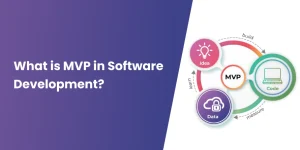How to Develop Custom Software: Step-by-Step Guide and Best Practices
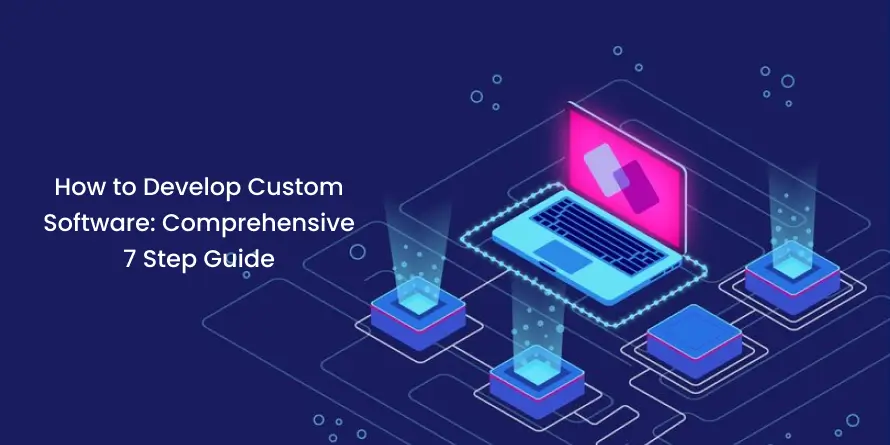
Consider building custom software like creating a custom-made suit. It’s not a one-size-fits-all solution. It’s the art of getting every stitch, seam, and detail precisely tailored to fit. Custom software development takes an understanding of your specific needs, objectives, and pain points to implement, whether you are creating a scalable enterprise system, or a small tool to enhance your business processes.
It’s about investing in a magic pen that fits perfectly into the business and should facilitate day-to-day processes while minimizing expenses and maintenance.
This blog will take you through every step of the way for developing custom software from zero. We’ll throw some light on steps to develop custom software from the ground stage to testing and deployment. So that you can turn your one-of-a-kind concept into a concrete solution. So, what are we waiting for, let’s get started to build the best-fit software for your business!
Why Should You Invest in Developing Custom Software?
In the fast-paced and crowded business landscape of today, relying on readymade software can often keep businesses behind. Although off-the-shelf solutions might appear to be an easy and cheap fix, they often fall short of your business’s specific needs and requirements, leaving you at a disadvantage.
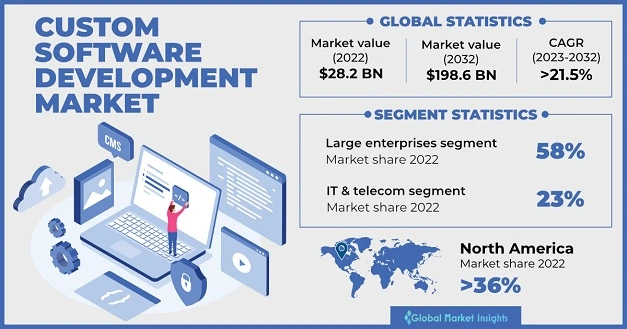
Source: Global Market Insights
A Statista survey found out that over 60% of enterprises claim that generic software does not accurately reflect their processes and support their needs. With businesses growing and evolving, the need for these custom solutions is highlighted even further.
Are You Struggling with These Common Pain Points of Ready-made Solutions?
- Do you lack the flexibility to customize your software?
- Are your systems struggling to integrate smoothly?
- Is scaling your business a challenge with your current software?
- Are you concerned about the security of your business’s data?
- Is your software filled with features you don’t need, and missing the ones you need the most?
Developing custom software is the answer to these common pain points. By creating a solution tailored to your specific business needs, you gain the flexibility to design a tool that works perfectly with your existing systems, grows as your business does, and includes only the features that matter the most.
It allows you to implement robust security measures, ensuring your business is protected. In the end, building custom software is an investment that helps you stay ahead of the competition, improve efficiency and scale seamlessly.
Step-by-Step Process to Develop Custom Software
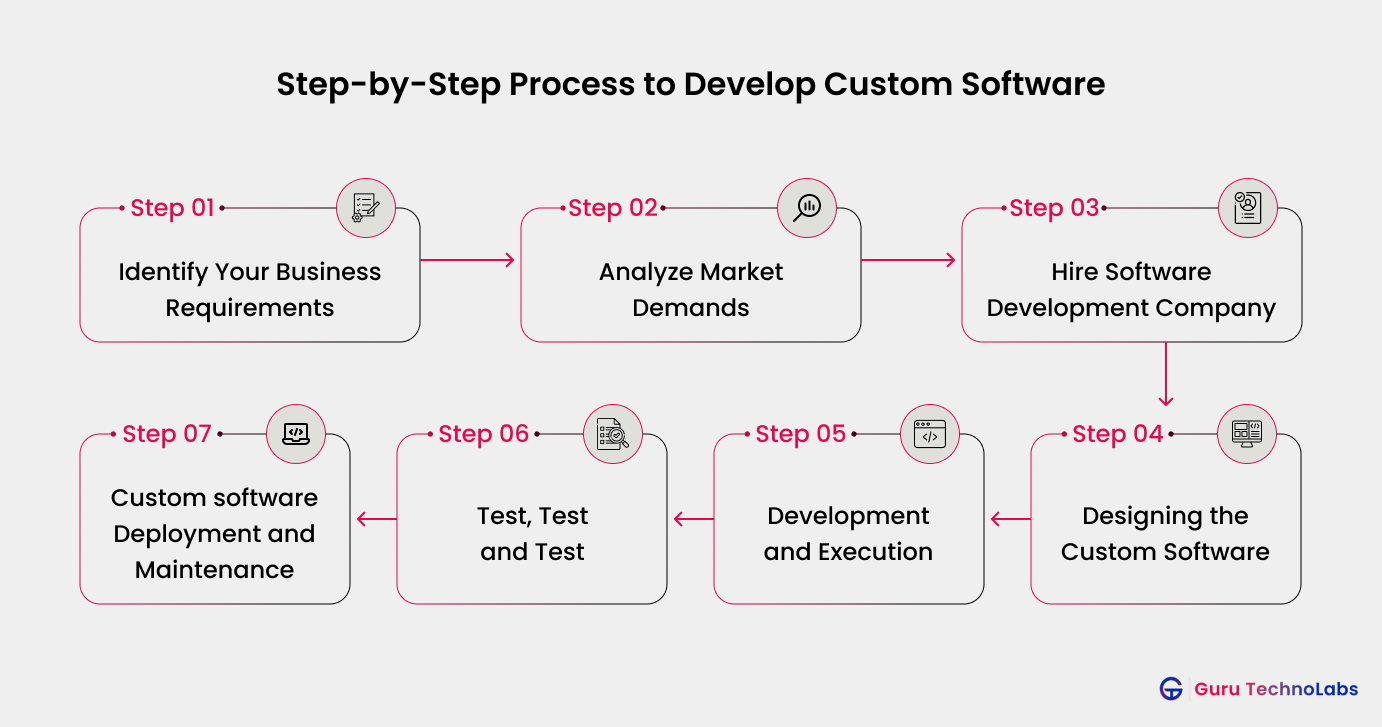
Developing custom software is a methodical process that requires careful planning, execution, and collaboration. Depending on the types of custom software you need, whether it’s an eCommerce platform, a CRM, or an ERP system, the process might slightly vary, but the core principles remain the same.
In this section, we will walk you through each critical step to help you bring your vision to life with precision and efficiency.
Identify Your Business Requirements
Before diving into creating custom software, you need to know what you’re building and why. What’s the problem you are trying to solve? Identifying your business requirements is the foundation of the entire project.
No matter what industry you’re in, whether you’re investing in a mobile app development solution or or building an MVP in software development, or an enterprise-level solution, it’s essential to fully understand the needs and challenges of your business first. Think of it as laying the groundwork for a building, where everything starts from a solid blueprint.
Question to ask yourself:
- What specific problems am I trying to solve with this software?
- What features do I need in the solution?
- How will this software improve or enhance my business?
Analyze Market Demands
Understanding market demand is the next step. This helps ensure that your software is not only tailored to your needs but also keeps up with current software development trends and customer expectations. You don’t want to invest in software that’s outdated before it even launches.
Research your competitors, talk to your customers, and analyze industry trends to understand what features are essential and what’s next on the horizon for your market.
Steps to analyze market demands:
- Conduct market research to identify common pain points
- Evaluate competitor solutions to see where your software can shine
- Collect feedback from current customers about their needs and frustrations
For instance, a healthcare company might realize that the demand for feature-rich telemedicine solutions and healthcare app is growing, and custom software could provide them with a unique platform to integrate video calls and patient management in one system.
Hire the Best in Class Software Development Company
Choosing the right custom software development company is the key to success in any project. There are a variety of development service providers available for each type of business, and businesses need to carefully consider when selecting one. There are three main types of development: onshore, offshore, and nearshore.
On-shore development means hiring the company in the same country as your company.
- On the other side, Offshore software development means hiring a software development team based in a foreign country, especially a country with low labor costs.
- Nearshore development refers to a development approach that is between onshore and offshore development. It means dealing with companies based on neighbouring or close countries.
- Many companies in the U.S., for example, select nearshore developers located in Latin America for the best combination of cost and ease of collaboration.
A business needs to consider multiple factors while hiring a software development team. Look for reviews on platforms such as Clutch and GoodFirms to see what previous clients have said about the company.
Check if we have experience with similar projects. The company’s portfolio is important to check. Technical competence is another priority—confirming that the company is proficient with modern programming languages and frameworks (think Python, Java, React, Node) should be exhaustively researched.
Also Read: How Much Does It Cost To Hire a Software Developer?
Designing the Custom Software
After selecting a development partner, the next crucial step is designing the software. This phase ensures that the final product meets business needs and user expectations.
- The process begins with requirement gathering, where stakeholders define the software’s objectives, essential features, and potential challenges.
- Conducting user research is also beneficial to understand the target audience’s pain points and expectations.
- Once the requirements are clear, the User Experience (UX) and User Interface (UI) design phase begins.
- UX designers create wireframes and prototypes to establish the software’s structure and navigation, while UI designers focus on visual elements such as color schemes, typography, and buttons.
- A well-designed interface significantly impacts user engagement and usability.
Another crucial aspect of software design is architecture selection. Businesses must decide between a monolithic or microservices architecture.
- Monolithic architecture involves building a single, unified system, which is simpler but less flexible.
- Microservices architecture, on the other hand, divides the software into smaller, independent services that communicate via APIs.
Additionally, choosing the right technology stack, including programming languages, databases, and frameworks is essential to ensure software efficiency and longevity.
A crucial part of this phase is prototyping, where an interactive model of the software is created. Prototyping helps in gathering early feedback from stakeholders and users, allowing necessary refinements before moving to development. Tools like Figma or Adobe XD are commonly used for this process.
Development and Execution
With the design finalized, the actual software development process begins. This stage involves writing code, integrating various components, and ensuring the application functions smoothly. The development team is typically divided into front-end, back-end, and database specialists.
- Front-end development focuses on building the user interface and ensuring a seamless experience. Developers use technologies like HTML, CSS, JavaScript, React, Angular, or Vue.js to create interactive and responsive interfaces.
- Back-end development, on the other hand, involves handling the logic, data processing, and server-side functions. Popular backend technologies include Node.js, Python (Django, Flask), Java (Spring Boot), and PHP (Laravel).
- A well-structured database is essential for efficient data management. Developers choose between SQL databases (MySQL, PostgreSQL, SQL Server) for structured data or NoSQL databases (MongoDB, Firebase, Cassandra) for more flexible data storage.
Modern software development also involves third-party integrations, such as API development, payment gateways, authentication services, and security features. Writing modular, reusable code and conducting regular code reviews improve maintainability. Developers often follow Agile or DevOps methodologies to streamline the development process, allowing for faster iterations and continuous feedback.
Testing and Quality Assurance
Testing is an indispensable part of software development that ensures the application functions correctly, securely, and efficiently. Various types of testing help identify and fix issues before deployment. Top software development company in market do various testing before they launch the software in the market.
| Testing Type | Purpose |
|---|---|
| Functional Testing | Ensures software meets functional requirements |
| Unit Testing | Tests individual components or modules |
| Integration Testing | Validates interactions between different modules |
| User Acceptance Testing (UAT) | Ensures the software meets business needs and user expectations |
| Performance Testing | Assesses speed, scalability, and responsiveness |
| Security Testing | Identifies vulnerabilities in the software |
Testing should be an ongoing process, even after deployment. Automated testing frameworks help in running tests quickly and efficiently, ensuring software reliability.
Custom Software Deployment and Maintenance
It is then deployed for real-world use once testing is finished. Deployment Strategies are based on the complexity of the project and business needs.
Some businesses like big bang deployment, in which the whole software goes live all together. The other approaches for mitigations are phased deployment, releasing features iteratively. With blue-green deployment, two identical environments run side by side, which can make switching between them easy and effective.
Another important aspect of post-deployment maintenance is scaling the software. When the business is growing, the software should be able to optimize it for high traffic and high data processing. A specialized support team will ensure that technical problems are quickly resolved.
Struggling with Off-the-Shelf Software That Doesn’t Fit Your Needs?
Get a custom software solution built specifically for your business challenges.
Say goodbye to limitations and boost productivity with tailored technology!
Best Practices or Methodologies for Successful Custom Software Development
When it comes to custom software development, choosing the right methodology can make or break a project.
But what does it mean?
A software development methodology is a framework or set of practices that guide how the development process unfolds. Think of it as a recipe that helps developers and stakeholders work together to build the best product. Depending on your project needs, there are several popular methodologies to choose from, each with its approach and style.
The four big ones you will probably hear about are Agile, Waterfall, DevOps, and Lean. Let’s dive into each of them and explore how they can help your project!
Agile Methodology
Agile is the flexible friend to create a custom software development. It does not believe in a perfect strategy but it adapts, thrives on teamwork, and agile integrations. Imagine you build a website with a team of people and instead of trying to finish absolutely everything including the rug in one shot, you decompose it into smaller chunks, let’s call them “sprints” and ship working features iteratively.
In this manner you receive real-time feedback, and can pivot if something is not working as expected. It’s like making a dish and tasting after every single move, you can change the recipe in real time!
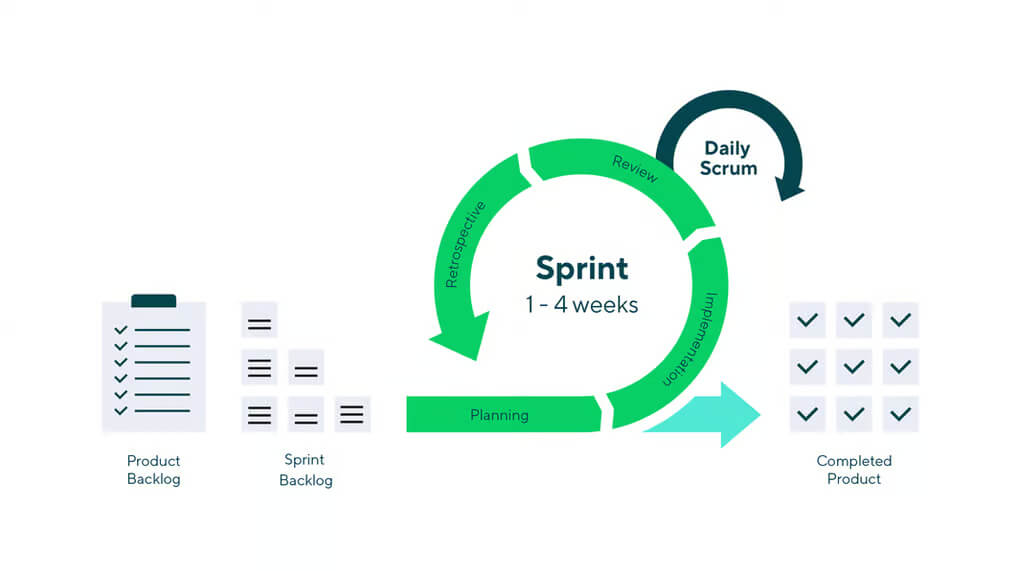
Source: Wrike
| Pros | Cons |
|---|---|
| Highly flexible and adaptable to changes | Can be hard to predict timelines and costs |
| Continuous feedback leads to better products | Requires close collaboration, which can be time-consuming |
| Regular updates keep stakeholders engaged | Potential for scope creep (endless changes) |
Where Agile suits the best:
- Projects where the end requirements aren’t fully clear from the start.
- When you need continuous feedback from stakeholders.
- Fast-paced environments with evolving user needs.
- Projects with smaller, cross-functional teams.
Waterfall Methodology
Unlike agile practice, which is typically less structured, waterfall is highly regimented. It’s kind of like a recipe that you’re following, step by step, and once you’ve done one phase, you go to the next phase and you don’t look back. It’s perfect for projects where you know exactly what you’re looking to get from the word go, and changes are few or impossible once the project is underway.
It’s like you’re building a house- you wouldn’t start putting in windows after you poured the concrete, right? Things are done in phases (sequentially).
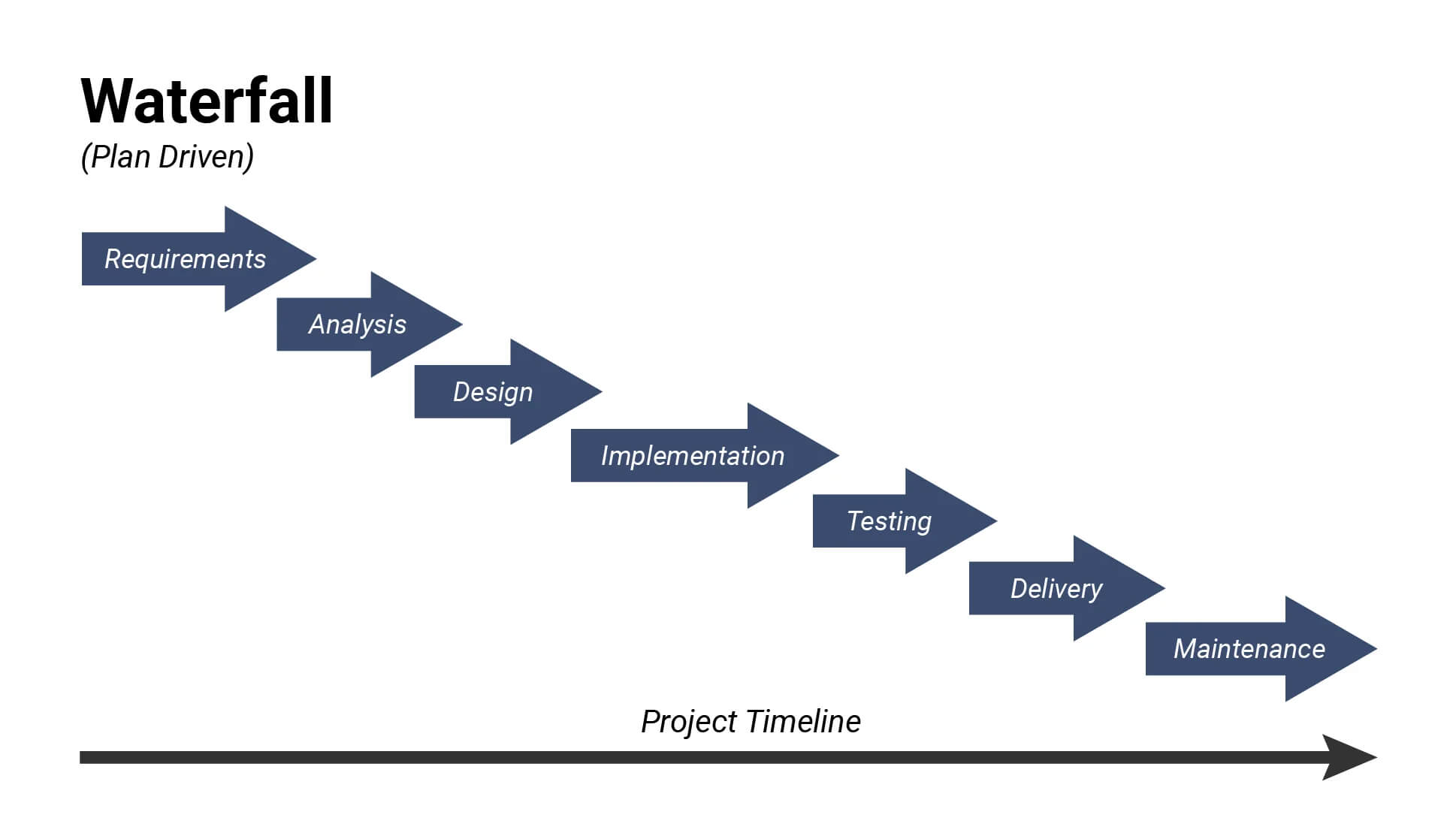
Source: actiTIME
| Pros | Cons |
|---|---|
| Clear, defined structure and timeline | Less flexibility to change once started |
| Well-documented process | Can be inefficient for complex projects with uncertain requirements |
| Easier to manage for smaller projects | Can result in delays if any stage has an issue |
Where Waterfall suits best:
- Large, well-defined projects like enterprise software development
- When requirements are clear and unlikely to change
- When precise documentation and planning are critical
- For projects with a fixed budget and timeline
DevOps Software Methodology
DevOps is a collaborative team, working together as a single unit, from the beginning to the end. It blends software development (Dev) with IT operations (Ops), emphasizing collaboration, automation, and continuous integration.
You are already familiar with DevOps as a kind of a band, musicians playing in harmony, the software developers produce the code, operations handle the infrastructure, and they work in conjunction to deliver software faster and reliably. Ever heard of Netflix rolling out updates multiple times a day? That’s DevOps for you!
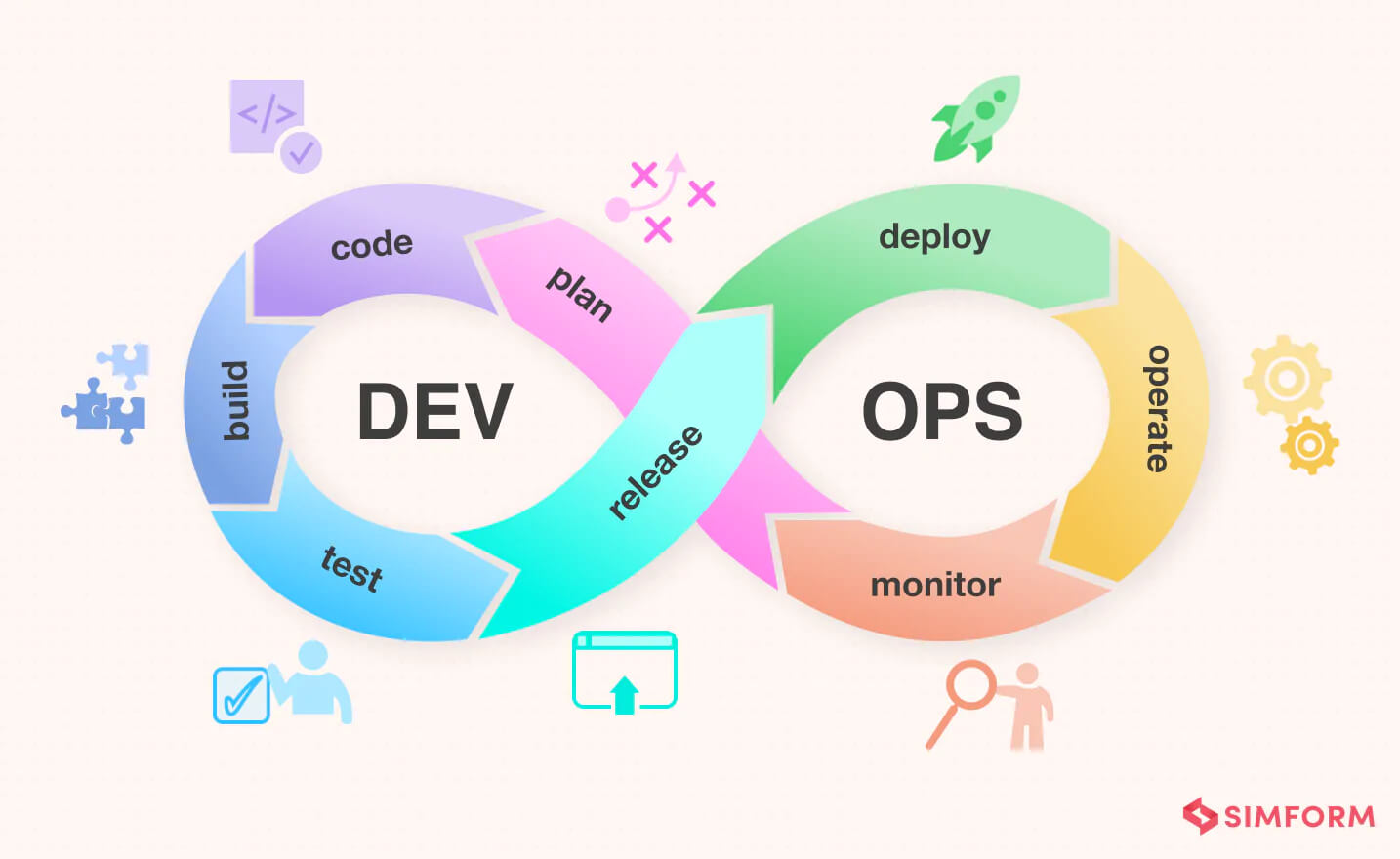
Source: Simform
| Pros | Cons |
|---|---|
| Faster and more reliable software releases | Require significant upfront investment in tools and training |
| Increased collaboration across teams | Can be challenging to implement in larger, less agile teams |
| Improved system reliability and stability | Potential for security risks with frequent updates |
Where DevOps Suites Best:
- Projects where fast, frequent releases are critical
- Companies with mature software development and operation teams
- Projects requiring high availability and rapid scaling
- Organizations looking to improve automation and reduce manual work
Lean Methodology
Lean is about efficiency. It is like doing a Marathon with minimal baggage – eliminating waste, shortening delays, and making value delivery the center of my universe. It is a methodology that started in lean manufacturing (Think Toyota Production) but now has been adapted to build software.
Lean aims to create a small piece of software that is valuable and can ship quickly and in small increments while removing everything that doesn’t add value to the customers. About making the most of = being more efficient with overall (process) activities and having each step taken provide enough progress.
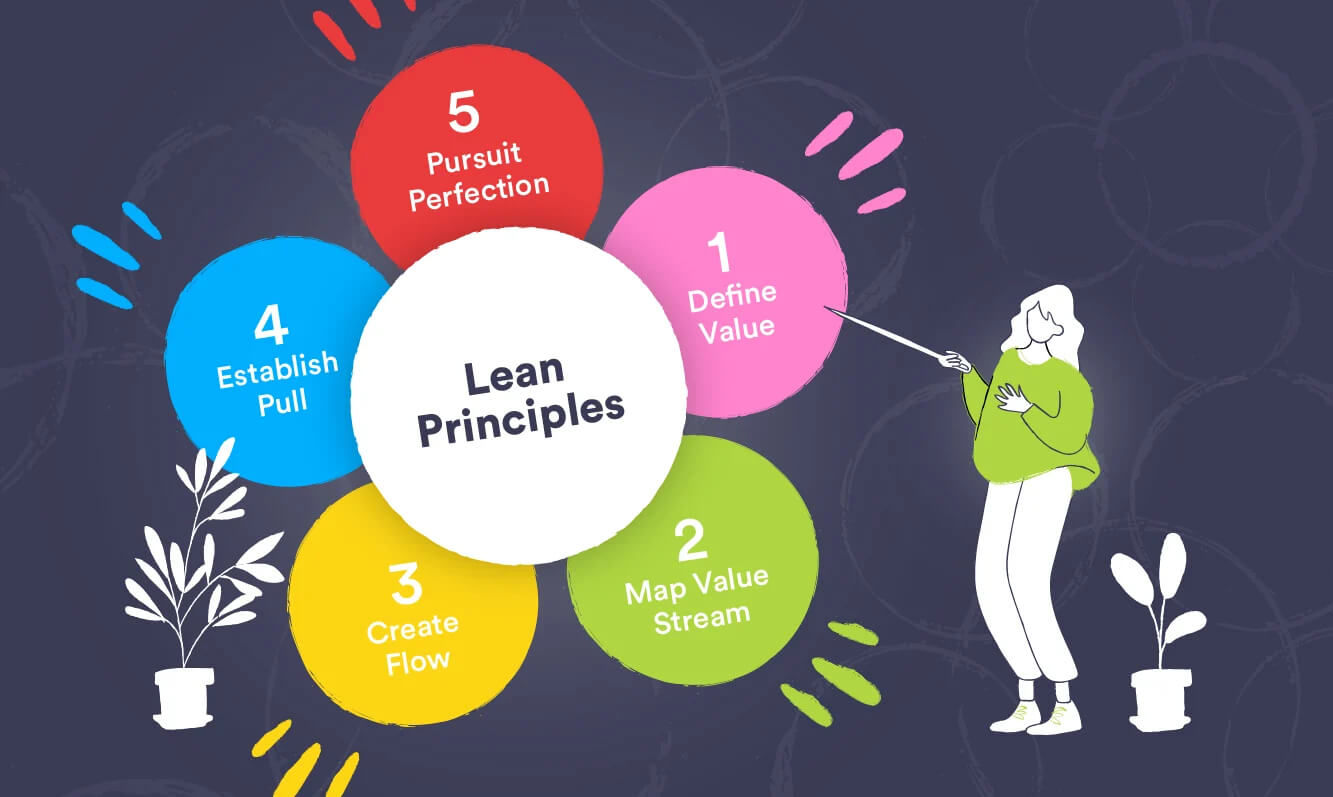
Source: Life QI
| Pros | Cons |
|---|---|
| Helps eliminate waste and inefficiencies | Can be too focused on speed, potentially sacrificing quality |
| Focus on delivering high-value features | Requires a mindset shift for teams used to more traditional approaches |
| Encourages continuous improvement | Hard to implement if the team is not aligned with the principles |
Where Lean Suites Best:
- Projects looking to reduce costs and increase efficiency
- When you need to prioritize value over features
- Focused teams on fast iteration and continuous improvement
- Projects where the customer feedback is critical for success
In the end, the best methodology depends on your project’s needs, the type of team you have, and the results you’re aiming for. So whether you’re looking for flexibility, structure, speed, or efficiency, there’s a development methodology out there that’ll suit your project like a glove!
Explore more software development methodologies for your next project in our in-depth article.
Cost of Developing Custom Software
The cost of developing custom software can vary significantly based on several factors. It’s not a one-size-fits-all situation. The complexity of the project, the technology stack, the team’s experience, and the location of your development partner all play a role in determining the final price.
If you choose a partner from a developed country, like the USA or Western Europe, you can expect higher rates due to the higher cost of living, advanced skill sets, and more experienced developers. However, this often comes with the benefit of top-notch quality and expertise.
Some of the key factors that influence the cost of software development include:
- Project complexity
- Location of development team
- Timeline
- Technology stack
- Maintenance and support
In short, the cost of custom software development can vary widely, and it’s important to balance budget, quality, and timelines when choosing a development partner.
Conclusion
Developing custom software is the key to solving many business challenges, and also comes with certain benefits. With a dedicated team of developers, a proven track record of successful projects and a commitment to client satisfaction, Guru TechnoLabs is the ideal partner for your custom software development needs.
In short, creating custom software offers businesses a smart way to achieve their specific goals and gain a competitive edge in today’s evolving markets. By understanding the complexity of custom software development, leveraging its benefits and choosing the right software development partner, businesses can welcome new opportunities for growth and success.
Moreover, emerging digital technologies are here to make software development better. So what are you waiting for? Contact us now, the sooner you embrace it, the stronger your business’s foundation will be.





